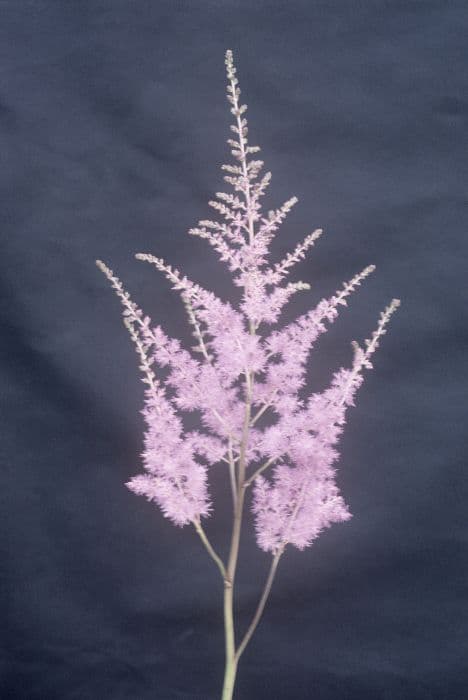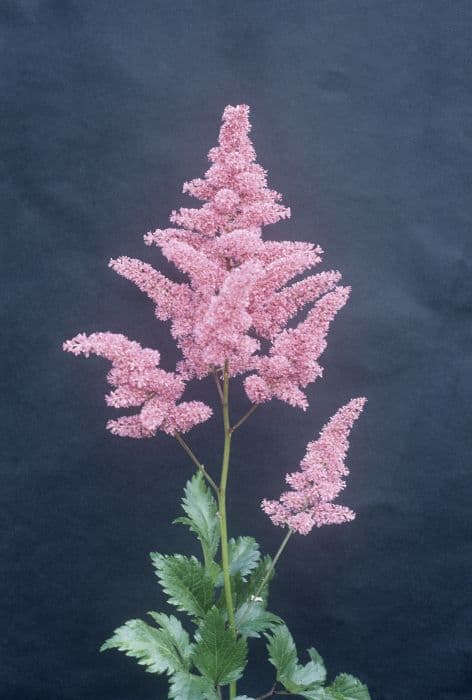False Goat's Beard Astilbe rivularis

ABOUT
Astilbe rivularis, commonly known as False Goat's Beard or Meadow Rue, is a flowering perennial known for its attractive foliage and feathery flower plumes. The plant has a bushy clump-forming habit, presenting deeply lobed, toothed, and sometimes glossy leaves that are often a rich green color. The leaves can vary in shape but usually feature compound structures with multiple leaflets arranged in a symmetrical pattern. The most striking feature of False Goat's Beard is its bloom, which consists of airy plumes made up of numerous tiny flowers. These blossom clusters appear on branching stems that rise elegantly above the foliage. The flowers can come in a range of colors, from white to various shades of pink and lavender. They have a fine, delicate texture that gives the plant a soft, feathery appearance. Beneath the foliage, the plant forms a network of fibrous roots that help it to anchor in the soil. The overall appearance of Astilbe rivularis is one of grace and feathery lightness, with a natural charm that can act as both a focal point in garden design and as an accompaniment to other plants in a garden border or shade garden. Its attractive foliage and whimsical flowers make it a popular choice for gardeners looking to add texture and color to their outdoor spaces.
About this plant
 Names
NamesFamily
Saxifragaceae
Synonyms
Meadow Sweet, Himalayan Astilbe
Common names
Astilbe rivularis Buch.-Ham. ex D. Don, Astilbe rivularis var. simplicifolia H. Hara, Rodgersia nepalensis Wall.
 Toxicity
ToxicityTo humans
Astilbe rivularis, commonly known as astilbe, is not widely recognized as a poisonous plant to humans. Typically, they do not contain toxic compounds that would cause serious harm if ingested in small quantities. However, it is generally recommended to avoid eating ornamental plants due to the potential for mild stomach upset or an allergic reaction in some individuals. There isn't enough data to characterize specific symptoms of poisoning from the astilbe plant, as it is generally considered non-toxic.
To pets
Astilbe rivularis, commonly known as astilbe, is not known to be toxic to pets such as dogs and cats. It does not appear on the toxic plant lists provided by major animal health organizations like the ASPCA. Therefore, if a pet were to ingest part of an astilbe plant, it is unlikely to cause poisoning. However, ingestion of any plant material can potentially lead to gastrointestinal upset in pets, manifested as vomiting or diarrhea. If you suspect your pet has ingested a large amount of astilbe or is showing signs of illness, consult your veterinarian.
 Characteristics
CharacteristicsLife cycle
Perennials
Foliage type
Deciduous
Color of leaves
Green
Flower color
White
Height
2-3 feet (60-90 cm)
Spread
2 feet (60 cm)
Plant type
Herb
Hardiness zones
5
Native area
Himalayas
Benefits
 General Benefits
General Benefits- Ornamental value: Astilbe rivularis, commonly known as false goat's beard, offers aesthetic appeal to gardens with its feathery flower plumes and fern-like foliage.
- Habitat for wildlife: The plant provides nectar for pollinators such as bees and butterflies, making it beneficial for supporting local ecosystems.
- Shade tolerance: It thrives in partial to full shade, making it an ideal choice for shaded gardens where many other plants may struggle to grow.
- Moisture-loving: False goat's beard prefers moist soils, making it suitable for planting near water features or in damp garden areas.
- Erosion control: Its root system helps stabilize soil in sloped or erosion-prone areas of the garden.
- Low maintenance: This perennial is relatively easy to care for, requiring minimal maintenance once established in appropriate growing conditions.
- Seasonal interest: It provides visual interest throughout multiple seasons with its changing leaf colors and flowering period during the summer.
 Medical Properties
Medical PropertiesThis plant is not used for medical purposes.
 Air-purifying Qualities
Air-purifying QualitiesThis plant is not specifically known for air purifying qualities.
 Other Uses
Other Uses- Astilbe rivularis, commonly known as false goat's beard, can be employed as a natural dye, where various parts of the plant may impart a range of colors to textiles and fibers.
- The plant is sometimes used in traditional ceremonies or rituals in certain cultures, particularly for its decorative flowers which symbolize protection or good luck.
- In landscape design, false goat's beard is utilized for its texture and foliage in creating contrasts with other plants in garden compositions.
- It serves as a useful educational tool in botany and horticulture for studying plant growth habits and reproductive mechanisms, due to its distinctive flowering structure.
- The fibrous roots of false goat's beard can be studied for soil stabilization properties and potentially used to prevent soil erosion on slopes and riverbanks.
- Because of its dense and bushy appearance, the plant is often used as a natural privacy screen or to define borders in garden settings.
- False goat's beard can be included in wildlife gardens to attract beneficial insects like bees and butterflies, aiding in pollination processes.
- The towering flower stalks may be dried and used in crafting, such as in the creation of natural wreaths, dried flower arrangements, or potpourri.
- Its cut flowers can be used in floristry, especially in wedding arrangements or as part of a bouquet due to their feathery and delicate appearance.
- During winter, its dried seed heads provide visual interest in otherwise barren gardens and can be a food source for birds and small mammals.
Interesting Facts
 Feng Shui
Feng ShuiThe Astilbe is not used in Feng Shui practice.
 Zodiac Sign Compitability
Zodiac Sign CompitabilityThe Astilbe is not used in astrology practice.
 Plant Symbolism
Plant Symbolism- Patient Love: Astilbe rivularis, commonly known as the 'false goat's beard', often symbolizes patient and enduring love, as it blooms reliably and with quiet grace.
- Devotion: The plant's resilient nature and the way it returns each year is seen as a symbol of constancy and devotion in relationships.
- Delicate Beauty: With its feathery plumes of flowers, the false goat's beard represents an appreciation for beauty that is intricate and tender.
- Hope and Prosperity: As it thrives in shady areas, the Astilbe rivularis is also seen as a symbol of hope and the belief that prosperity can bloom in unexpected places.
 Water
WaterFalse Goat's Beard should be watered deeply whenever the soil feels dry to the touch, approximately an inch below the surface. This typically means watering at least once or twice a week during the warmer months. It’s important to give the plant a good soak, so aim for about 1 gallon per square foot of soil each time you water. In drier conditions or hot spells, increase watering frequency to maintain consistent soil moisture, ensuring the plant remains hydrated. Reduce watering in cooler seasons to prevent waterlogging.
 Light
LightFalse Goat's Beard thrives in partial to full shade, avoiding direct sunlight particularly in the afternoon when the sun is most intense. The best spot for this plant would be a location that receives filtered sunlight or dappled shade throughout the day; a spot under the canopy of open-branched trees or on the north side of buildings can be ideal.
 Temperature
TemperatureFalse Goat's Beard prefers cool to moderate temperatures and thrives between 60 to 75°F. The plant can survive minimum temperatures down to about 20°F but may suffer if exposed to intense, prolonged freezes. It is less tolerant of high heat, especially with inadequate watering, so avoid locations where temperatures exceed 80°F for extended periods.
 Pruning
PruningFalse Goat's Beard benefits from pruning to remove spent flowers and brown foliage, encouraging reblooming and maintaining a tidy appearance. Deadheading, or cutting back the old flower stalks after blooming, promotes a second flush of flowers. The best time for any major pruning is in late winter to early spring before new growth begins.
 Cleaning
CleaningAs needed
 Soil
SoilThe False Goat's Beard thrives in moist, humus-rich soil with good drainage and a soil pH range of 6.0 to 7.0. A mixture of loamy soil, peat, and perlite or coarse sand is ideal to ensure proper moisture retention and aeration.
 Repotting
RepottingFalse Goat's Beard should generally be repotted every 2-3 years to avoid becoming root-bound and to refresh the soil medium.
 Humidity & Misting
Humidity & MistingFalse Goat's Beard prefers high humidity levels, ideally around 60-80% to mimic its natural moist habitat.
 Suitable locations
Suitable locationsIndoor
Place in well-draining soil, under indirect light, and maintain high humidity.
Outdoor
Plant in semi-shade, moist soil, and mulch to retain moisture.
Hardiness zone
4-8 USDA
 Life cycle
Life cycleAstilbe rivularis, commonly known as false goat's beard, begins its life cycle as a dormant rhizome, which germinates in early spring. The plant emerges from the soil, producing a rosette of leaves and developing a strong root system. As the season progresses, the foliage grows lush, and the plant prepares for its reproductive phase. By mid to late summer, it produces tall, feathery plumes of tiny flowers, which are often white or pale pink, attracting pollinators such as bees and butterflies. After pollination, the flowers develop into small, dry capsules that contain seeds, allowing for propagation either by self-sowing or intentional collection for replanting. As winter approaches, the above-ground foliage dies back, and the plant returns to its dormancy stage, relying on its rhizomes to survive until the next growing season.
 Propogation
PropogationPropogation time
Spring-Early Summer
Propogation: The most popular method for propagating Astilbe rivularis, commonly known as False Goat's Beard or False Spirea, is by division. The best time to propagate by division is in the early spring or late fall, when the plant is dormant. To do this, carefully dig around the plant and lift it from the ground. Use a sharp knife or spade to divide the plant into smaller clumps, ensuring that each section has at least 2-3 growth buds. Replant the divisions immediately, spacing them about 12 to 24 inches (30 to 61 centimeters) apart to give them adequate room to grow. Water the new plants thoroughly to help establish their roots in the soil.









